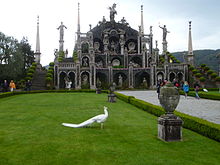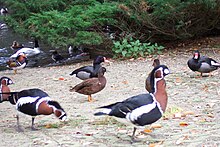Ornamental fowl



As ornamental fowl is called poultry , not as livestock bred, but as a focal point in parks or in aviaries is held. The ornamental poultry includes species of chicken birds (Galliformes), pigeon birds (Columbiformes) and goose birds (Anseriformes).
Ornamental poultry farming
Ornamental poultry farming began in the 17th century and was initially limited to "park poultry" in the palace gardens of the aristocracy , and "wild fowl", such as the pheasant , for hunting . It later became more popular.
Millers and landowners kept peacocks as a status symbol and showed that they could keep poultry for no use, just for the sake of its beauty. Botanical gardens and zoos kept ornamental poultry to make their facilities more attractive. Breeders and hobbyists took on the semi- domesticated bird species and sometimes also bred mutation forms of these species. Well-known mutations of the blue peacock are the black- winged peacock , the white peacock and the pied peacock ; the lutino pheasant and the cinnamon-colored , salmon-red and dark golden pheasants are mutations of the golden pheasant ; there are color deviations in the mandarin duck and diamond pigeon .
Today, zoos and botanical gardens are more critical of the keeping of alien species , as feral populations have developed from captive refugees or ornamental birds kept in free flight, which are now increasingly hostile to them. In Europe, the Egyptian goose and the mandarin duck belong to these free-reproducing bird species, known as neozoa , which can be traced back to being kept as ornamental fowl .
Species protection and conservation are important efforts in ornamental poultry keeping today. Some breeders publish their observations and take part in scientific work, others breed special species and make the animals available as part of reintroduction programs. The renunciation of wild catches and mass imports was laid down in 1992 in the resolution on the problem of species protection by the Association of Ornamental Poultry Breeders in the BDRG .
Ornamental poultry species
Not all bird species are suitable for keeping ornamental poultry. The Association for the Preservation of Species of Zier- / Wildgeflügel (VZI) eV in the BDRG differentiates between chicken-like ornamental poultry , ornamental pigeons and water fowl . The European Association for Poultry, Pigeon, Rabbit and Cavia Breeding and the Association of German Poultry Breeders name selected species of the following families and genera:
in the BDRG also: |
|
|
literature
- Ulrich Reber: Guide to ornamental poultry farming (= expert knowledge of poultry farming ). Oertel + Spörer, Reutlingen 2009, ISBN 978-3-88627-546-5 .
- Swiss Racial Poultry Association (SRGV): Guidelines for keeping ornamental poultry. ( Memento from June 27, 2013 in the Internet Archive ) 2007 (PDF file, ee-entente.com, accessed on September 14, 2012; 192 kB)
Web links
Individual evidence
- ↑ a b Reber 2009, p. 9.
- ^ Ortwin Grossmann: Pfauen. In: Huehnerhof.net. Retrieved March 25, 2013 .
- ↑ Reber 2009, p. 9, p. 51, p. 53.
- ↑ Species protection - Resolution on the problem of species protection by the Association of Ornamental Poultry Breeders in the BDRG , accessed on September 14, 2012.
- ↑ Ornamental fowl. (PDF, approx. 31.5 kB) In: http://www.entente-ee.com/ . European Association for Poultry, Pigeon, Bird, Rabbit and Cavia Breeding, January 31, 2011, accessed on March 27, 2013 (multilingual, (de, Dutch, French, en), including ring sizes).
- ↑ Breed index and ring sizes. In: http://www.bdrg.de/ . Association of German Poultry Breeders, p. 4ff. , accessed on March 27, 2013 (including ring sizes).
